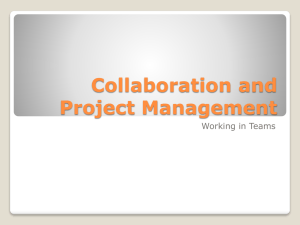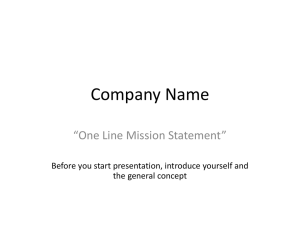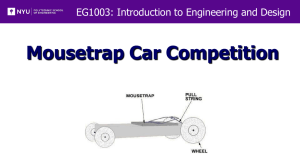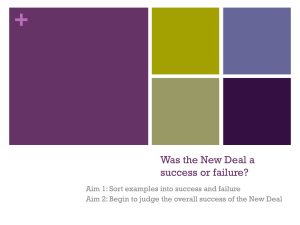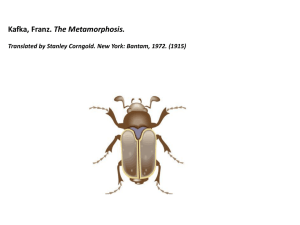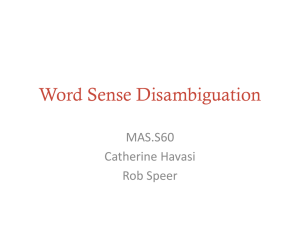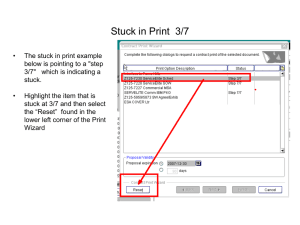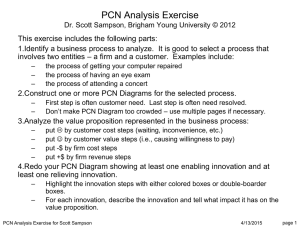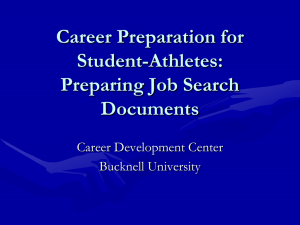File - Isles District 4
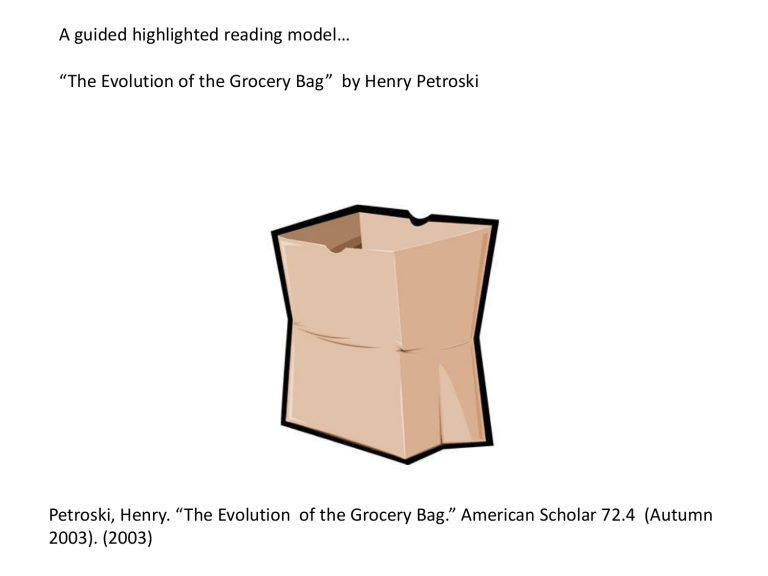
A guided highlighted reading model…
“The Evolution of the Grocery Bag” by Henry Petroski
Petroski, Henry. “The Evolution of the Grocery Bag.” American Scholar 72.4 (Autumn
2003). (2003)
1. Petroski, Henry. “The Evolution of the Grocery Bag.” American Scholar 72.4 (Autumn 2003). (2003)
2. That much-reviled bottleneck known as the American supermarket checkout lane would be an even
3. greater exercise in frustration were it not for several technological advances. The Universal
4. Product Code and the decoding laser scanner, introduced in 1974, tally a shopper’s groceries far
5. more quickly and accurately than the old method of input- ting each purchase manually into a
6. cash register. But beeping a large order past the scanner would have led only to a faster pileup of cans and boxes
7.
down the line, where the bagger works, had it not been for the introduction, more than a century earlier, of an
8.
even greater technological masterpiece: the square-bottomed paper bag.
9. The geometry of paper bags continues to hold a magical appeal for those of us who are
10. fascinated by how ordinary things are designed and made. Originally, grocery bags were created on
11. demand by storekeepers, who cut, folded, and pasted sheets of paper, making versatile containers
12. into which purchases could be loaded for carrying home. The first paper bags manufactured
13. commercially are said to have been made in Bristol, England, in the 1840s. In 1852, a “Machine for
14. Making Bags of Paper” was patented in America by Francis Wolle, of Bethlehem, Pennsylvania.
15. According to Wolle’s own description of the machine’s operation, “pieces of paper of suitable length are given
16. out from a roll of the required width, cut off from the roll and otherwise suitably cut to the required
17. shape, folded, their edges pasted and lapped, and formed into complete and perfect bags.” The
18. “perfect bags” produced at the rate of eighteen hundred per hour by Wolle’s machine were, of
19.
course, not perfect, nor was his machine. The history of design has yet to see the development of a perfect
20.
object, though it has seen many satisfactory ones and many substantially improved ones. The concept of
21.
comparative improvement is embedded in the paradigm for invention, the better mousetrap. No one is ever likely
22.
to lay claim to a “best” mousetrap, for that would preclude the inventor himself from coming up with a still better
23.
mousetrap without suffering the embarrassment of having previously declared the search complete. As with the
24.
mousetrap, so with the bag.
In line 1, highlight the word that means any process of formation or growth; development.
In line 2, highlight the word that is a synonym for abused or vilified.
In line 3, highlight the word that usually refers to advances in industry and science.
In line 4, highlight the word that means to translate.
In line 4, highlight the word that describes computing the total cost.
In line 8, highlight the word that describes a significant achievement or work.
In line 9, highlight the mathematical term describing the shape or form of a surface or solid.
In line 11, highlight the term that describes something capable of or adapted for turning easily from one to another.
In line 13, highlight the adverb that describes when something is suitable or fit for a wide, popular market.
In line 14, highlight the noun that means the exclusive right granted by a government to an inventor to manufacture, use, or sell an invention for a certain number of years.
In line 20, highlight the adverb that means of ample or considerable amount, quantity, size.
In line 21, highlight the adjective that describes things being alike or different.
In line 21, highlight the noun that describes when something is incorporated or contained as an essential part or characteristic.
In line 21, highlight the noun that describes a pattern or model.
1. Petroski, Henry. “The Evolution of the Grocery Bag.” American Scholar 72.4 (Autumn 2003). (2003)
2. That muchreviled bottleneck known as the American supermarket checkout lane would be an even
3. greater exercise in frustration were it not for several technological advances. The Universal
4. Product Code and the decoding laser scanner, introduced in 1974, tally a shopper’s groceries far
5. more quickly and accurately than the old method of input- ting each purchase manually into a
6. cash register. But beeping a large order past the scanner would have led only to a faster pileup of cans and boxes
7.
down the line, where the bagger works, had it not been for the introduction, more than a century earlier, of an
8.
even greater technological masterpiece: the square-bottomed paper bag.
9. The geometry of paper bags continues to hold a magical appeal for those of us who are
10. fascinated by how ordinary things are designed and made. Originally, grocery bags were created on
11. demand by storekeepers, who cut, folded, and pasted sheets of paper, making versatile containers
12. into which purchases could be loaded for carrying home. The first paper bags manufactured
13. commercially are said to have been made in Bristol, England, in the 1840s. In 1852, a “Machine for
14. Making Bags of Paper” was patented in America by Francis Wolle, of Bethlehem, Pennsylvania.
15. According to Wolle’s own description of the machine’s operation, “pieces of paper of suitable length are given
16. out from a roll of the required width, cut off from the roll and otherwise suitably cut to the required
17. shape, folded, their edges pasted and lapped, and formed into complete and perfect bags.” The
18. “perfect bags” produced at the rate of eighteen hundred per hour by Wolle’s machine were, of
19.
course, not perfect, nor was his machine. The history of design has yet to see the development of a perfect
20.
object, though it has seen many satisfactory ones and many substantially improved ones. The concept of
21.
comparative improvement is embedded in the paradigm for invention, the better mousetrap. No one is ever likely
22.
to lay claim to a “best” mousetrap, for that would preclude the inventor himself from coming up with a still better
23.
mousetrap without suffering the embarrassment of having previously declared the search complete. As with the
24.
mousetrap, so with the bag.
For summary…
In line 3, highlight what it was that kept supermarket checkout lanes from being even more frustrating.
In lines 3 and 4, highlight the term for what was introduced in 1974 that caused a speed-up of inputting a shoppers grocery choices.
In line 8, highlight what when and what was introduced that made the 1974 change even more effective.
In lines 9 and 10, highlight what it is that fascinates people who are fascinated by the geometry of the paper bag.
In lines 10 and 11, highlight how originally paper bags were made.
In lines 12 and 13, highlight the sentence that describes where the first paper bags were supposedly made.
In lines 13 and 14, highlight what was introduced in 1852, where and who patented it.
In lines 17 and 18, highlight the sentence that describes the amount of bags produced and how good they were and how well the machine worked.
In lines 19 and 20, highlight what the history of design has yet to see.
In line 21, highlight what is embedded in the paradigm for invention.
In lines 21-23, highlight what the inventor would avoid.
1. Petroski, Henry. “The Evolution of the Grocery Bag.” American Scholar 72.4 (Autumn 2003). (2003)
2. That much-reviled bottleneck known as the American supermarket checkout lane would be an even
3. greater exercise in frustration were it not for several technological advances . The Universal
4. Product Code and the decoding laser scanner, introduced in 1974, tally a shopper’s groceries far
5. more quickly and accurately than the old method of input- ting each purchase manually into a
6. cash register. But beeping a large order past the scanner would have led only to a faster pileup of cans and boxes
7.
down the line, where the bagger works, had it not been for the introduction, more than a century earlier, of an
8.
even greater technological masterpiece: the square-bottomed paper bag .
9. The geometry of paper bags continues to hold a magical appeal for those of us who are
10. fascinated by how ordinary things are designed and made. Originally, grocery bags were created on
11. demand by storekeepers, who cut, folded, and pasted sheets of paper, making versatile containers
12. into which purchases could be loaded for carrying home. The first paper bags manufactured
13. commercially are said to have been made in Bristol, England, in the 1840s. In 1852, a “Machine for
14. Making Bags of Paper” was patented in America by Francis Wolle, of Bethlehem, Pennsylvania.
15. According to Wolle’s own description of the machine’s operation, “pieces of paper of suitable length are given
16. out from a roll of the required width, cut off from the roll and otherwise suitably cut to the required
17. shape, folded, their edges pasted and lapped, and formed into complete and perfect bags.” The
18. “perfect bags” produced at the rate of eighteen hundred per hour by Wolle’s machine were, of
19.
course, not perfect, nor was his machine. The history of design has yet to see the development of a perfect
20.
object , though it has seen many satisfactory ones and many substantially improved ones. The concept of
21.
comparative improvement is embedded in the paradigm for invention, the better mousetrap . No one is ever likely
22.
to lay claim to a “best” mousetrap, for that would preclude the inventor himself from coming up with a still better
23.
mousetrap without suffering the embarrassment of having previously declared the search complete.
As with the
24.
mousetrap, so with the bag.
Writing the summary…
On the lines provided on the back of the text you’ve just highlighted, write a 4-6 line summary of the text you’ve just read and highlighted. You may refer back to the text as needed. Try to include the essential ideas from the text in your own words as much as possible.
Multiple Choice Quiz…
1.
What was considered a “much-reviled bottleneck”? a.
Los Angeles freeways b.
c.
Ticket offices at National Football stadiums
Supermarket checkout lanes
2.
3.
What was introduced in 1974?
a. Cash registers b. Check out lanes c. Universal Product Code and laser scanners
How many years earlier had an even greater technological masterpiece been introduced?
a. 20 years b. More than 100 years c. A decade
4.
5.
How were the first paper bags created?
a. Customers made their own b. Storekeepers cut, folded and pasted sheets of paper c. Volunteers, working for a charity, made them
When are the first paper bags manufactured commercially said to have been made?
a. 1066 b. 1776 c. 1840s
6.
In 1852, a “Machine for Making Bags of Paper was patented by which person?
a. Benjamin Franklin b. Issac Newton c. Francis Wolle
7. How many bags were produced per hour by the first machine?
a. 100 b. 3,000 c. 1800
8. What is considered to be the “paradigm” for invention?
a. The umbrella b. The mousetrap c. The milk carton
To consider…
1. How did the “square-bottomed paper bag” make a difference in people’s lives?
2. What has been the “evolution” of bags since the development of the paper bag?
3. Why are some cities now requiring stores to use paper bags?
4. Why do you think the history of design has yet to see the development of a perfect object?
5. If you could name a perfect object, what would it be?
6. Why is the mousetrap considered the “paradigm” for invention?
7. Do you think anyone will ever design the “perfect” object?

